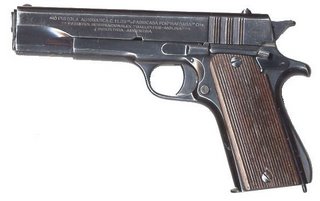Thursday, August 31, 2006
Fabrique Nationale (FN) Browning "High Power" (HP) (Belgium)
 Browning High Power made by FN (model 1935)
Browning High Power made by FN (model 1935)

Browning High Power, also made by Inglis, but with tangent ajustable rear sights and attached holster/shoulder stock
 Browning High Power Mk. III - modern military/law enforcement variation
Browning High Power Mk. III - modern military/law enforcement variation Browning High Power - modern commercial version with ajustable sights and ambidextrous safety
Browning High Power - modern commercial version with ajustable sights and ambidextrous safety
Browning High Power barrel to slide interlocking schematic
Buy FN High Power pistols and accessories at ImpactGuns online store
Type: Single Action
Chambering: 9mm Parabellum (also 7.65mm Parabellum and .40S&W in commercial/civilian models)
Length overall: 200 mm
Barrel length: 118 mm
Weight: 885 g
Magazine: 13 rounds (10 rounds in .40SW)
Initially, the "High Power" pistol was designed by John M. Browning in 1925 and was patented in the USA in 1927, soon after the death of the Browning. The design was aquired by Belgian state-owned company FN Herstal, and improved by FN designer Dieudonne Saive. The resulting pistol was shelved until 1935, when Belgian army was ready to adopt new sidearm. The HP was offered for trials and won, and was adopted as a Model 1935 pistol. Soon after that it was also adopted by Belgian police and by many foreign countries, including Britich Commonwealth ones (UK, Canada, Australia etc.). The High Power is the only sidearm that served for both sides in WW2 - Germany used many HPs manufactured in occupied Belgium, while Allies used HPs manufactured mostly in Canada by company Inglis. The HP continues its service well into XXI century with belgian Army and Police, British army and many other military and Law Enforcement agencies, being second longest living service pistols after the another famous Brownings' design, the Colt 1911.
Thechnically, the High Power pistol, also known as Browning HP 35, GP 35 or Model 1935, is a recoil operated, locked breech pistol. It uses linkless barrel to slide locking (see picture above), invented by Browning. The trigger is single action, with external hammer. Original HPs featured frame mounted safety at the left side of the frame, that locks both sear and slide. Modern versions, since Mark II, also featured ambidextrous safety levers, that are also more comfortable to operate. Original HPs were available with two sight wersions - with standart fixed sights, and with rear tangent sights ajustable for distance from 50 to 500 meters. Some pre- and WW2-time guns also featured backstraps with cuts to accomodate removable shoulder stocks/holsters. Grip panels were made from wood, and pistols were availabli with or without lanyard rings. The HP was the first military pistol to have high capacity, staggered column magazine for 13 rounds plus one loaded in the chamber.
Newer Military/LE versions, such as Mk.II and recent Mk.III (also marketed under the name of HP-SA with added firing pin safety), featured more modern fixed combat sights and polymer grip panels. Commercial models may feature different sight options and finiches. Lates addition to the High Power family is a variation chambered in .40S&W cartridge. It has redesigned and strenghtened slide to accomodate more powerful cartridge, and magazine capacity of 10 rounds.
In 1980's or so FN also developed version of the HP with double action trigger, that was named HP-DA. It is still marketed by FN, but didn't catch the market as well as its predescessor did.
Copies and clones of the HP are still manufactured around the worls, such as Hungarian FEG 9, Bulgarian Arcus etc.
Browning 1910, 1922 and 380 (Belgium)
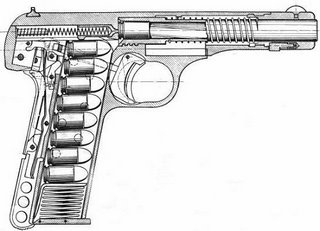
Type: Single Action
Chamber: 7.65x17mm Browning (.32ACP) and 9x17mm Browning (.380ACP)
Weight unloaded: model 1910 - ca. 590 g; model 1922 - ca. 700 g
Length: model 1910 - 153 mm; model 1922 - 178 mm
Barrel length: model 1910 - 88 mm; model 1922 - 113 mm
Capacity: model 1910 - 7 (7.65mm) or 6 (9mm) rounds; model 1922 - 9 (7.65mm) or 8 (9mm) rounds
Model 1910 pistol had been developed by John M. Browning for Belgian company Fabrique Nationale (FN), Herstal. Model 1910 had been developed around two cartridges, also designed by Browning - the 7.65mm Browning, also known as .32ACP, which had been developed around 1900 for FN / Browning model 1900 pistol, and the 9mm Browning Short (9x17mm), also known as .380ACP, which, in turn, had been developed about 1908 for Colt / Browning model 1908 pistol.
In 1922, Browning modified the original pistol to suit requirements of the Jugoslavian military - he lenghtened barrel, enlarged the grip and magazine capacity by two rounds. The slide was lenghtened by adding removable frontal portion to the model 1910 slide.
Both models 1910 and 1922 were manufactured in large quantities until 1983 or so, when these guns were replaced by FN model 140DA / Browning BDA380 pistols. In the USA both model 1910 and model 1922 were imported under the name of "Browning 380 pistol", chambered in .380ACP. After the 1971, these guns have had ajustable target-type sights and slightly enlarged grips to suit new US gun laws. Between two World Wars these pistols became very popular across Europe as a police, military and self-defence guns. It is well-known also that the First World War was started by the Browning m1910 pistos, which had been used in 1914 to assasinate the Archduke Ferdinand.
Technically, both m 1910 and m 1922 (also known as model 1910/22), are blowback operated semi-automatic pistols. The recoil spring is located around the barrel, the trigger is of single action type and the gun is striker-fired. Both models featured three safeties - magazine safety (which blocks the firing when magazine is removed), automatic grip safety and manual, frame mounted safety.
FN / Browning M.1903 (Browning No.2) pistol (Belgium)
 FN - Browning M 1903 pistol
FN - Browning M 1903 pistol FN - Browning M 1903 pistol cross-section drawing
FN - Browning M 1903 pistol cross-section drawing Type: Single Action, Semi-automatic pistol
Chamber: 9x20mm SR Browning Long, 7.65x17mm SR Browning (.32ACP)
Weight unloaded: 930 g
Length: 205 mm
Barrel length: 127 mm
Capacity: 7 rounds (9mm) or 8 rounds (7.65mm)
The M1903 was the second production blowback-operated pistol, designed by famous American arms designer John Browning by 1902 and patented in 1903. Also known as the Browning No.2 pistol, this design was a serious improvement over the older No.1 (FN - Browning M1900) pistol. At the same time Browning developed the recoil-operated M1900 for Colt. This design also was manufactured by the Colt Firearms Co of USA as the Colt M1903 pocket pistol, chambered in .32ACP (7.65mm). Both FN and Colt produced this design until 1930s. In Europe, The FN M1903 became a favorite police pistol, and also was adopted by several armies, included Belgian, Dutch, Turkish and Swedish ones, as well as by Imperial Russian police. It was manufactured in Sweden under license at Husqvarna Vapenfabriks from 1917 and until 1942, as the 9mm M/1907. In the USA, the Colt m1903 became popular as a civilian self-defense pistol, and also was issued to the senior army officers and generals as a standard self-defense weapon. FN built slightly less than 60 000 M1903 pistols, plus Husqvarna built another 94 000 pistols.
This pistol can be called as a forerunner of most semi-automatic pistols in the world, in one or another respect. Significantly underpowered by modern standards, it was, however, reliable, accurate and comfortable to carry and fire. It also offered much faster reloading procedure than any of contemporary military revolvers.
Technical description.
The Browning M1903 (does not matter, if it was made by FN in Belgium or by Colt in USA), is a blowback operated, semi-automatic pistol. The recoil spring was located under the barrel, as in most modern pistols. The single action trigger unit has a concealed hammer (Colt also produced similar models with open hammers). The non-pivoting trigger is somewhat similar to the latter Colt/Browning M1911 trigger. Manual safety switch is located at the left side of the frame, above the grip panel. When engaged, it locks the sear and the slide. It also locks the slide in the open position for disassembly. Additional automatic grip safety locked the sear unless the gun is properly held in the palm. Barrel is locked to the frame by several radial ribs. To disassemble the pistol, one must retract the slide, lock it open with the safety, then rotate barrel out of engagement with the frame, and then remove barrel and slide. Automatic slide stop (hold open) device was also incorporated, with the visible lever located at the right side of the frame, above the triggerguard. Single stack magazine is inserted in to the butt and locked by the lever at the heel of the grip. Military issue pistols also had lanyard ring on the left side of the grip.
--
FN / Browning M.1900 (Browning No.1) pistol (Belgium)
Type: Single Action, semi-automatic pistol
Chamber: 7.62x17mm SR (.32ACP)
Weight unloaded: 625 g
Length: 172 mm
Barrel length: 102 mm
Capacity: 7 rounds
The FN / Browning model 1900 pistol was a first of a long and extremely successful series of the Belgian-made pistols, designed by the American firearms genius John Moses Browning. The first semi-automatic, blowback operated pistol was designed by J. M. Browning circa 1896 and latter improved by the 1897. He offered his design to Belgian company FN Herstal circa 1898, and production began in 1899, as the Modele 1899. in 1900, this pistol, in slightly modified form (with barrel shortened from 122 to 102 mm), was adopted by Belgium as Mle.1900. Relatively simple and well designed, this pistol is also known as the Browning Number 1 pistol (Browning No.1). Widely used across Europe as a civilian and police sidearm, this was chambered for a new smokeless round, 7.62x17mm SR, which is also known in Americas as the .32ACP (.32 Colt Automatic). FN - Browning M1900 was widely copied in many countries, especially in S-E Asia. It was manufactured until the 1911 or so, with more than 700 000 pistols made.
Technical description.
The M1900 is a blowback operated, semi-automatic (self-loading) pistol. The barrel is fixed to the frame. The recoil spring is located within the slide and above the barrel. This spring, via special lever, also acts as a firing pin spring. M1900 is a striker fired, single action weapon. Unlike all latter designs, the ejection port is cut in the frame, and not in the slide. Safety switch is located at the left side, above the grip panel. Magazine is removable, is inserted into the pistol handle and holds 7 rounds. Magazine catch lever is located at the heel of the grip. Sights are fixed.
--
Bersa Thunder-380 pistol (Argentine)
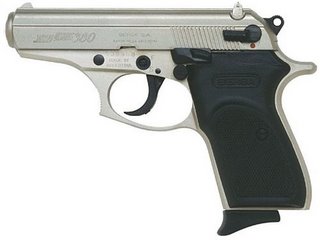

Buy Bersa pistols and accessories at Impact Guns online store
Type: Double Action
Calibers: 9x17mm Short/Kurz (.380ACP) and 7.65x17SR (.32ACP)
Weight unloaded: 560 gram
Length: 168 mm
Barrel length: 90 mm
Capacity: 7 (9mm) or 9 (7.65mm) rounds standard
Bersa Thunder-380 pistols are manufactured in Argentine by Bersa S.A. company, as a compact self-defense side arms for civilians and police. being inexpensive and of good quality, these pistols offer a good level of protection with decent ergonomics. These pistols must not be confused with larger and more powerful Bersa Thunder 9 and Thunder 40 pistols from the same company.
Bersa Thunder-380 pistols are simple blowback operated, with the return spring located around the barrel. The trigger is of double action type, with exposed hammer. The safety switch is located at the left side of the frame, and, when engaged, automatically decocks the hammer. There is also an internal firing pin safety, which blocks the firing pin unless the trigger is pressed. Magazine release button is located above and behind of the trigger guard, at the left side of the frame, and just below of the slide stop lever. Single stack magazine holds seven 9mm (.380) or nine 7.65mm (.32) rounds. Deluxe versions of the Thunder-380 are equipped with extended magazines, which hold nine rounds of 9mm/.380 ammunition. Front sight is integral to the slide, rear fixed sight is dovetailed to the slide. Latest production pistols also feature an integral key lock, located above the trigger, on the left side of the frame.
--
Thursday, August 10, 2006
Bersa Thunder and Thunder Mini / Ultra-Compact pistols (Argentine)
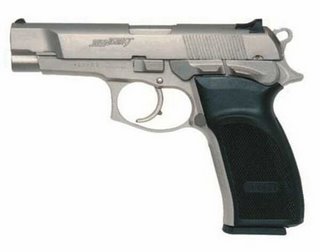

Bersa Thunder-mini 9mm, right side
Buy Bersa pistols and accessories at Impact Guns online store
| Thunder 9 and 40 | Thunder 9 and 40 Mini / Ultra-Compact | Thunder Ultra-Compact 45 | |
| Type | Double Action | ||
| Caliber | 9x19mm Luger and .40S&W | 9x19mm Luger and .40S&W | .45ACP |
| Weight unloaded | 870 gram | 765 gram | 780 gram |
| Length | 192 mm | 165 mm | 173 mm |
| Barrel length | 110 mm | 83 mm | 92 mm |
| Capacity, rounds | 17 (9mm) or 13 (.40) | 13 (9mm) or 10 (.40) | 7 |
Bersa pistols are manufactured in Argentine by the Bersa S.A. company. Thunder pistols are available, in several different versions. The Thunder-380 pistols are of simple blowback design, while more powerful Thunder-9, Thunder-40 and Thunder-45 pistols are of locked breech design. Thunder series pistols are relatively compact and handy, yet they offer significant capacity with major pistol calibers, combined with good, fully ambidextrous ergonomics. Bersa pistols also are relatively inexpensive and offer decent reliability, making them good personal defense firearms. The only differences between Thunder and Thunder-mini pistols (which also sold as Thunder Ultra-Compact) are size and magazine capacity. The Ultra-Compact .45 pistols are roughly intermediate in size between standard and mini pistols, and, unlike smaller caliber brothers, they have a single stack magazine.
Bersa Thunder 9 pistols are standard issue pistols for the Argentinean Federal Police and the Buenos Aires Province Police.
Bersa Thunder-9, Thunder-40 and Thunder-45 pistols are locked breech, short recoil operated firearms of Browning type. barrel is locked to slide by single large lug, which engages the ejection port in the slide. The unlocking is caused by the cam-shaped underbarrel extension. Trigger is of double action type, with exposed hammer and ambidextrous frame mounted safety, which decocks the hammer when engaged, then locks the slide and sear. The action also features a firing pin safety, which blocks the firing pin until the trigger is pressed. The slide release lever also is ambidextrous, and the magazine release button can be easily mounted on the either side of the grip. magazines of the 9mm and .40SW versions are of double stack type, .45 caliber magazines are single stack. Sights are fixed, with front sight integral to the slide and rear dovetailed to the frame. Latest production pistols also feature an integral key lock, located above the trigger on the left side of the frame, as well as accessory laser / light rail on the frame below the barrel.
--
Ballester-Molina / Ballester-Rigaud pistol (Argentine)

Ballester-Molina pistol, right side
Type: Single Action
Calibers: .45ACP
Weight unloaded: 1075 gram
Length: 216 mm
Barrel length: 127 mm (5")
Capacity: 7 rounds
The Ballester-Molina pistol, originally known as Ballester-Rigaud (so marked during first years of manufacture, circa 1938 to 1940), were made in Argentine by Hispano Argentina de Automotives SA (HAFDASA) company. Manufacture started in 1938 in attempt to provide Argentinean police and military with less expensive alternative to the Colt modelo 1927 pistol, domestically made licensed copy of the American Colt M1911A1 pistol. Production of the Ballester-Molina ceased in the early 1950s. While Ballester-Molina pistol is externally very similar to Colt, it has significant differences, especially in the safety and trigger unit arrangements. Actually, the only parts exchangeable between Ballester-Molina and M1911A1 are the barrel with link and the magazine. The trigger and safety arrangements were more or less copied from the Spanish Star pistols, with the pivoting trigger, single trigger to sear link, and no grip safety. Ballester-Molina pistols were used by Argentinean military and police, as well as supplied to the Britain during Second World war. Britain issued these pistols to their Special Operations Executives agents, which usually operated behind enemy lines.
The Ballester-Molina pistol is a short recoil operated, locked breech pistol. the locking system is similar to that of Colt M1911A1, with the swinging link used to unlock the barrel from the slide. The single action trigger is pivoted on the axis, the frame-mounted manual safety locks the slide and the hammer.
--
Steyr M and M-1A pistol (Austria)

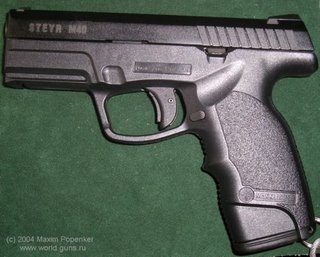 Steyr M-1A in .40SW caliber, version without manual safety
Steyr M-1A in .40SW caliber, version without manual safety Steyr M-1A in 9mm caliber, version with manual safety. Safety is in "ON" position (push-button with white dot immediately ahead of the trigger)
Steyr M-1A in 9mm caliber, version with manual safety. Safety is in "ON" position (push-button with white dot immediately ahead of the trigger)
Steyr M-1A in 9mm caliber, version with manual safety. Safety is in "OFF" position (ready to fire; push-button is depressed up and into the frame). The pistol is also fitted with laser pointer.
Type: Double Action (Reset Action System)
Chamber: .40 S&W, 9x19mm Para, .357 SIG
Weight unloaded: 780g
Length: 180 mm
Barrel Length: 101 mm
Capacity: 12 (.40 & .357) or 15 (9mm) rounds
The Steyr M series pistols were first announced in 1999. Steyr M pistols, along with compact version, Steyr S, which were made in Austria by the Steyr-Mannlicher GmbH & Co, are not made any more. Since the January 1st, 2004, the Steyr M and Steyr S pistols have been replaced in production by the slightly redesigned Steyr M-1A pistols. Steyr M1-A pistols feature redesigned grip and frame shape, and Picatinny rail (instead of the proprietary rail) under the barrel. Another change from original M series pistols is that M-1A pistols are now available in two variants, with or without manual safety. There are probably some more minor differences.
The Steyr M and M-1A pistols have probably the most ergonomic grip since the Luger's "Parabellum" pistol. The ideal 111 degrees grip angle, combined with low barrel axis, results in minimum muzzle jump and felt recoil, as well as in good "pointability". The unusual "trapezoid" sights, while uncommon in shape, provide good accuracy and acquisition speed, once shooter gets used to it. Reliability is also very good.
The Steyr M-1A pistols are short recoil operated, locked breech firearms. The barrel is operated by Browning cam system. Barrel locks into slide via large ejection window. The frame is made from high impact-resistant polymer, with integral Picatinny rail under the barrel. The slide stop lever and magazine release button are located on the left side of the frame. The Double Action trigger controls the internal striker. The unusual safety system consists of several separate safeties, including the automatic trigger and firing pin safeties, as well as unusual manual safety and internal lock. When the lock is engaged, it completely blocks the operation of pistol. The safety is controlled with dual buttons, which are located just above the trigger guard on both sides of the frame. When buttons are depressed simultaneously, the safety button springs down from the frame, and the trigger is blocked. To turn the safety off for fire, a shooter must push the safety button up with its index finger. There also is a version of the M-1A pistol which doesn't have a manual safety. The standard sights feature a trapezoid rear sight and a triangle front. Both sights are dovetailed into the slide and can be replaced with variety of the factory or aftermarket sights in various configurations.
--
Steyr GB (Austria)
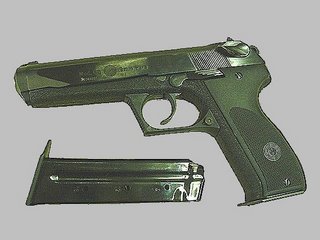
 Steyr GB - cut-out drawing
Steyr GB - cut-out drawing Type: Double Action
Chamber: 9x19mm Luger/Parabellum
Weight: 845 g empty; 1285 g loaed
Length: 216 mm
Barrel length: 136 mm
Capacity: 18 rounds
The development of the GB pistol was started by Steyr-Daimler-Puch AG (now Steyr-Mannliher AG), Austria, in the early 1970s, when the Austrian army announced its plans to replace aging P38s and High Powers with the new pistol. Original design, labelled as PI-18, was developed in 1974, and final version, called GB, entered production in 1981. The production of the GB was ceased circa 1988, after some 15.000 to 20.000 pistols had been produced.
The GB is a blowback-operated, gas-retarded blowback semi auto pistol. It uses some of the hot powder gases, feed from the barrel into the front part of the slide, to slow down the retraction of the slide before the bullet leave the barrel. This scheme was developed by German engineer Barnitzke at the end of the WW2. The gas brake is formed by the barrel, its bushing and the slide.
The trigger of the GB is of double action design, with the slide mounted decocker lever. GB also featured firing pin block that unlocks the firing pin only when the trigger is completely depressed.
The frame and the slide is made from carbon steel with special high-strenght finish. Barrel has polygonal rifling and is chrome lined, and solidly attached to the frame.
The sights are fixed and featured white-dot inserts (one in the front sight blade and two - around the rear sights notch).
Some early GBs were manufactured with steel grip panels, with all the rest manufactured with plastic checkered grips.
Thanks to its gas-retarded blowback design and solid weight, that resulted in low felt recoil, and to the barrel with polygonal rifling, that toesn't move when firing, the Steyr GB displayed wery good accuracy. The reliability is also adequate, at least. While the GB failed at the Austrian and USA Army pistol trials (won respectively by Glock 17 and Beretta 92FS-B), it was used by some Law Enforcement and Special Operations forces, and also was sold to civilians in Europe and USA.
Glock family of handguns (Austria)
 Glock 17 - basic model (9mm); Modern version with finger grooves on the grip and underbarrel acessory rail.
Glock 17 - basic model (9mm); Modern version with finger grooves on the grip and underbarrel acessory rail. Glock 18 - select-fire model (9mm). Early version with extended barrel and integral compensator.
Glock 18 - select-fire model (9mm). Early version with extended barrel and integral compensator.Note fire mode selector switch on the slide
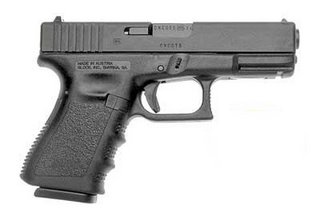 Glock 19 - semi-compact model (9mm)
Glock 19 - semi-compact model (9mm)
Glock 26 - compact model (9mm)
Click here to see Glock parts diagram (.GIF, 25Kb)
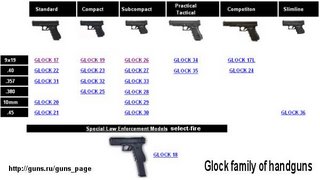
The Glock family of pistols, once started by famous Glock 17 pistol, was developed by Austrian company Glock Gmbh., previously known for quality knives and entrenching tools. The Glock 17 pistol first appeared at the Austrian Army trials, won it and was adopted by Austrai Army and Police in the early 1980s under the designation of P-80. Since then, the Glock 17 and its descentants become very popular military and law enforcement firearms, being exported in more than 50 countries. Currently, Glocks are chambered in all major pistol calibers, namely 9x17mm Short (.380ACP), 9x19mm Luger, .357SIG, .40SW, 10mm auto and .45ACP. Also, Glocks available in full-size service models, semi-compact models, compact models for concealed/backup carry, and in longslide competition models. Training versions, firing non-lethal practice ammo, also available. Training versions are distinguished from "live" ones by frame colour - blue frame for guns that fire non-lethal ammunition and red frame - for non-firing guns.
All Glocks (except for ones chambered in 9x17 - .380ACP) are recoil operated, locked breech pistols. Glocks feature Browning-type linkless locking system with barrel interlocking with slide via ejection port. All Glocks feature patented "Safe action" striker-fired trigger mechanism. After the each cycle of the slide the striker is set to half-cock position and is safely blocked by internal safety. When shooter pulls the trigger, he disengades the trigger safety first, then cocks the striker to the full-cock and then fires the gun. This results in constant trigger pull (ajustable from 2 to 5.5 kg) and, unlike the traditional DA or DAO pistols, unavailability of the "second strike" option in case of the misfire. All Glocks has no external controls except the trigger and the slide stop (the only different is Glock 18, which has slide mounted fire mode selector).
The .380ACP / 9x17mm Short chambered Glocks (models 25 and 28) differs from the rest of the Glock family by operating by simple blowback principle. These pistols targeted for civilian markets where ownership of the firearms chambered in "military" calibers is prohibited, or for those shooters who can't withstand more severe recoil of the "bigger" calibers.
All Glocks feature polymer frame, steel slides made by precision moulding process and had Tenifer heat-threatment to increase rust and wear risistance. early Glocks had plain grips with slight serrations. Modern variants has finger grooves on the front strap of the grip, and ambidextrous thumb rests. Also, modern versions featured underbarrel acessory rails. Barrels has hexagonal rifling in all calibers. Both front and rear sights are dovetailed and usually had white or luminous inserts. Ajustable sights are available for competition models.
Almost all models had modifications with factory-ported barrels. These models are marked with suffix "C" after the model number, i.e. Glock 17C.
The Glock 17 (and only model 17) could be modified with "amphibious kit" that allows underwater firing (in wery shallow depths, thought). Basically, the underwater shooting itself has wery little effect in real combat, since the effective range is extermely short. The real purpose of that feature is to show the strenght of the gun and to allow safe shoting in severe weather conditions, with possible water in the barrel (in many guns this may result in blown barrel).
The select-fire version of the Glock, called Glock 18, available only in 9mm Luger and only for Military / Law enforcement sales. Glock 18 could fire single shots or three-shot bursts. Glock 18 may be equipped with 31-rounds extended magazines and after-market folding stocks. For security reasons, some parts of the Glock 18 ARE NOT interchangeable with Glock 17/19 pistols. The theoretical rate of fire in full-auto mode is 1200 rounds per minute.
9x19mm Glock family basic data (.40SW and .357SIG models has the same dimensions, but weight slightly more)| GLOCK 17 | GLOCK 18 (select-fire) | GLOCK 19 | GLOCK 26 | |
| Lenght, mm | 186 | 186 | 174 | 160 |
| Barrel lenght, mm | 114 | 114 | 102 | 88 |
| Weight empty, g | 625 | 625 | 595 | 560 |
| Capacity, rds | 10, 17, 19, 31 | 10, 17, 19, 31 | 10, 15, 17 | 10, 12 |
Handguns
(semi-auto pistols and revolvers)
What is the modern handgun? Why is this piece of crafted metal and (recently) hard plastics still in great demand not only in military forces and police departments ALL around the world? The answers are: They are small, lightweight (well, most of them :-) and provide good firepower; suitable, not only for defensive situations, but for offensive ones, and even for medium game hunting. Of course, for each situation, careful choice of the proper handgun AND ammunition must be made. Handguns are divided into a few classes: semi-autos (or pistols), revolvers, and non-autos (single or multibarreled, single-shot or magazine fed). Semi-autos use part of the energy produced by burning cartridge powder to remove the used cartridge from the chamber, cock the hammer (or striker) and load a new cartridge in the chamber, so the pistol will be ready for the next shot. Cartridges are usually fed from a box magazine, located in the pistol's handle. Box magazines may contain up to 15 cartridges (or more) in single or double columns, depending on the pistol model, and are easy (and very quick) to reload.
Semi-autos use part of the energy produced by burning cartridge powder to remove the used cartridge from the chamber, cock the hammer (or striker) and load a new cartridge in the chamber, so the pistol will be ready for the next shot. Cartridges are usually fed from a box magazine, located in the pistol's handle. Box magazines may contain up to 15 cartridges (or more) in single or double columns, depending on the pistol model, and are easy (and very quick) to reload.Click here to view one of the classic semi-autos designs - a Colt/Brownings' 1911 [72Kb image]
 Revolvers got their name from the rotating (or Revolving) cylinder, which contains cartridges. Usually the cylinder holds from 5 to 7 loads, although some .22 caliber revolvers may contain up to 8-10 cartridges. Loads in the cylinder may be reloaded in 2 ways (depending on revolver design) - one by one, as, for example, the Colt PeaceKeeper does (and almost all old-timers), or all simulateounosly - when the cylinder is switched to the side or when the is frame "broke open."
Revolvers got their name from the rotating (or Revolving) cylinder, which contains cartridges. Usually the cylinder holds from 5 to 7 loads, although some .22 caliber revolvers may contain up to 8-10 cartridges. Loads in the cylinder may be reloaded in 2 ways (depending on revolver design) - one by one, as, for example, the Colt PeaceKeeper does (and almost all old-timers), or all simulateounosly - when the cylinder is switched to the side or when the is frame "broke open."Click here to view double-action revolver design by S&W [87Kb image]
Both revolvers and semi-autos have two main "action styles": Single action and Double action.
Single Action means, that the Revolver must be manually cocked (and, thus, the cylinder is rotated to the next cartridge) for each shot. This mode was the only one available in all old-time revolvers (such as the Peacekeeper), and is still available in most double-action revolvers. This mode improves accuracy but slows the fire rate. For Semi-autos, Single Action means that the pistol must be manually cocked for the first shot (usually, this is done by pulling the slide - this action cocks the hammer and feeds a cartridge into the chamber). For the second, and all consecutive shots, cocking is done automatically, when recoil force pulls back the slide.
Double Action for the Revolver means that the hammer for each (including the f irst) shot is cocked by trigger pull (this action also rotates the cylinder to the next position). This mode speeds up the firing rate and simplifies shooting actions, but greatly increases trigger pull (from 2.2-4.4 lbs usually found in single-actions, to 8.8-12.2 lbs in double-actions). For the Semi-autos, the hammer is usually cocked by trigger pull for the first shot only; the second and the rest are done in single-action mode. However, first load must be fed in the chamber by the slide pull. Some (most of them - compact) semi-autos and revolvers employ Double-action-only mode, which cocks the trigger for each shot, thus excluding single-action.
One of the biggest questions about handguns is: Why the Six-guns (a slang TERM for Revolvers) are stil alive when there's a big lot of the very reliable and larger capacity semi-auto handguns? The oldest answer is - reliability. Usually, given the same price (in low- or mid-range of prices), the revolvers were more reliable, primarily, because of the simplicity of the design. Today there's a lot of inexpensive semi-autos, that can hold twice or even triple as much loads ready to fire, than the common sixguns. But revolvers still alive. One of the main reasons to keep the revolver is that they're almost insencetive to ammunition. If your cartridge is capable of pushing a bullet thru the barrel of the sixgun - you got the working gun. No jams, no stoppages. Even in the case of the misfire you just got to pull the trigger again - and next round will go. In semi-auto, you need sufficient power to cycle the slide, thus rendering underpowered loads almost inoperable in semi-autos. Also, in case of the misfire, or jam, you should manually cycle the slide to fire the next round. In defensive scenario, this may cos you another second, and may be - your life. So, in general, sixguns are far less sensetive to ammo quality, and, due to simplicity and inherent design features, could withstand far more abuse. Also, when you go to the other, high-end of the loads (speaking in the terms of power), no semi-autos could withstand the power of loads such as .454casull or .475Linebaugh. Sixguns could.
Main drawbacks of the sixguns are small ammo capacity, slower reloading and bulkier size. While 6 rounds may be sufficient for self-defence scenarios, it may be really insufficient for the police or SpecOps actions. Also, replacing the magazine in semi-auto ususlly is much faster process than reloading a revolvers' drum. And, due to significant cylinder diameter, even the 5-shot revolvers are harder to carry concealed, than the modern compact handguns, while the latter could hold tvice as much cartridges.
Final selection of the guns is, undoubtfully, the owners' responcebility, but, in my opinion, revolvers are more suitable for civilians' self-defence and for hunting, while semi-autos are better combat and police guns.
Related videos - recommended
Tales of the Gun: Tales of the Gun: Automatic PistolsAutomatic Pistols Trace the development of the controversial weapons at the heart of today?s debate over gun control.
Click this button to Buy
Subscribe to Comments [Atom]







